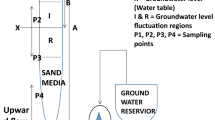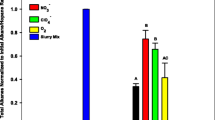Abstract
Hydrocarbon-contaminated soil and groundwater at oil and gas production sites may be additionally impacted by salts due to release of produced waters. However, little is known about the effect of salt on the in-situ biodegradation of hydrocarbons by terrestrial microbes, especially at low temperatures. To study this effect, we prepared a groundwater-soil slurry from two sites in Canada: a former flare pit site contaminated with flare pit residue (Site A), and a natural gas processing facility contaminated with natural gas condensate (Site B). The slurry with its indigenous microbes was amended with radiolabeled hydrocarbons dissolved in free product plus nutrients and/or NaCl, and incubated in aerobic biometer flasks with gyrotory shaking at either 25 or 10°C for up to 5 weeks. Cumulative production of 14CO2 was measured and the lag time, rate and extent of mineralization were calculated. For Site A, concentrations of NaCl ≥1% (w/v) delayed the onset of mineralization of both 14C-hexadecane and 14C-phenanthrene under nutrient-amended conditions, but once biodegradation began the degradation rates were similar over the range of salt concentrations tested (0–5% NaCl). For Site B, increasing concentrations of NaCl ≥1% (w/v) increased the lag time and decreased the rate and extent of mineralization of aliphatic and aromatic substrates. Of particular interest is the observation that low concentrations of salt (≤1% NaCl) slightly stimulated mineralization in some cases.




Similar content being viewed by others
References
Amatya PL, Hettiaratchi JPA, Joshi RC (2002) Biotreatment of flare pit waste. J Can Petrol Technol 41:30–36
Atlas RM (1981) Microbial degradation of petroleum hydrocarbons: an environmental perspective. Microbiol Rev 45:180–209
Bartha R, Pramer D (1965) Features of a flask and method for measuring the persistence and biological effects of pesticides in soil. Soil Sci 100:68–70
Børresen MH, Rike AG (2007) Effects of nutrient content, moisture content and salinity on mineralization of hexadecane in an Arctic soil. Cold Regions Sci Technol 48:129–138
deCarvalho CCCR, daFonseca MMR (2005) Degradation of hydrocarbons and alcohols at different temperatures and salinities by Rhodococcus erythropolis DCL14. FEMS Microbiol Ecol 51:389–399
Fedorak PM, Westlake DWS (1981) Microbial degradation of aromatics and saturates in Prudhoe Bay crude oil as determined by glass capillary gas chromatography. Can J Microbiol 27:432–443
Foght JM, Fedorak PM, Westlake DWS (1990) Mineralization of [14C]hexadecane and [14C]phenanthrene in crude oil: specificity among bacterial isolates. Can J Microbiol 36:169–175
Foght J, Semple K, Gauthier C, Westlake D, Blenkinsopp S, Sergy G, Wang Z, Fingas M (1999) Effect of nitrogen source on biodegradation of crude oil by a defined bacterial consortium incubated under cold, marine conditions. Environ Technol 20:839–849
Haines JR, Kadkhodayan M, Mocsny DJ, Jones CA, Islam M, Venosa AD (1994) Effect of salinity, oil type, and incubation temperature on oil degradation. In: Hinchee RE, Anderson DB, Metting FB, Sayles GD (eds) Applied biotechnology for site remediation, 2nd international symposium on in situ and on-site bioreclamation, San Diego, USA, 1993. Lewis Publishers, Boca Raton, pp 75–83
Head IM, Swannell RPJ (1999) Bioremediation of petroleum hydrocarbon contaminants in marine habitats. Curr Opin Biotechnol 10:234–239
Kleinsteuber S, Riis V, Fetzer I, Harms H, Müller S (2006) Population dynamics within a microbial consortium during growth on diesel fuel in saline environments. Appl Environ Microbiol 72:3531–3542
Margesin R, Schinner F (2001) Biodegradation and bioremediation of hydrocarbons in extreme environments. Appl Microbiol Biotechnol 56:650–663
Mille G, Almallah M, Bianchi M, van Wambeke F, Bertrand JC (1991) Effect of salinity on petroleum biodegradation. Fresenius J Anal Chem 339:788–791
Nicholson CA, Fathepure BZ (2004) Biodegradation of benzene by halophilic and halotolerant bacteria under aerobic conditions. Appl Environ Microbiol 70:1222–1225
Oren A, Gurevich P, Azachi M, Henis Y (1992) Microbial degradation of pollutants at high salt concentrations. Biodegradation 3:387–398
Pollard SJT, Hrudey SE, Fedorak PM (1994) Bioremediation of petroleum- and creosote-contaminated soils: a review of constraints. Waste Manag Res 12:173–194
Rhykerd RL, Weaver RW, McInnes KJ (1995) Influence of salinity on bioremediation of oil in soil. Environ Pollut 90:127–130
Riis V, Kleinsteuber S, Babel W (2003) Influence of high salinities on the degradation of diesel fuel by bacterial consortia. Can J Microbiol 49:713–721
Röling WFM, Milner MG, Jones DM, Lee K, Daniel F, Swannell RJP, Head IM (2002) Robust hydrocarbon degradation and dynamics of bacterial communities during nutrient-enhanced oil spill bioremediation. Appl Environ Microbiol 68:5537–5548
Ward DM, Brock TD (1978) Hydrocarbon biodegradation in hypersaline environments. Appl Environ Microbiol 35:353–359
Acknowledgements
This project was funded by the Water Research Users Group, Alberta Environment and was part of the Consortium for Research on Natural Attenuation (CORONA, funded by the NSERC Collaborative Research and Development (CRD) program). Summer student funding to KP was received from the NSERC USRA program. In-kind support by Devon Canada Ltd., Conoco-Phillips Canada Ltd., WorleyParsons Komex International Ltd. and Maxxam Analytics is gratefully acknowledged.
Author information
Authors and Affiliations
Corresponding author
Rights and permissions
About this article
Cite this article
Ulrich, A.C., Guigard, S.E., Foght, J.M. et al. Effect of salt on aerobic biodegradation of petroleum hydrocarbons in contaminated groundwater. Biodegradation 20, 27–38 (2009). https://doi.org/10.1007/s10532-008-9196-0
Received:
Accepted:
Published:
Issue Date:
DOI: https://doi.org/10.1007/s10532-008-9196-0




